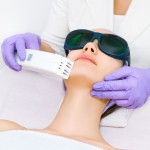 Patient Injuries and Lawsuits Involving Medical Lasers Are Increasing. Is Your Practice Compliant with Safety Regulations?
Patient Injuries and Lawsuits Involving Medical Lasers Are Increasing. Is Your Practice Compliant with Safety Regulations?By
Mark Dahlby, Attorney at
Hall, Render, Killian, Heath & Lyman, P.C.In 2007, the majority of physicians responding to an American Society for Dermatologic Surgery ("ASDS”) survey reported that the number of patients they were treating for complications caused by non-physicians was increasing. These complications frequently involved burns caused by the improper use of lasers, scarring caused by chemical peels, hyperpigmentation caused by laser hair removal and many instances of skin cancer being overlooked due to the removal of malignant tissue that could have otherwise served as a warning sign.
An
article published in the February issue of JAMA Dermatology looked specifically at malpractice litigation from 1985 to 2012 involving dermatologic laser procedures and concluded that litigation has been increasing and is resulting in indemnity payments that exceed the previously reported average across all medical specialties. Like the ASDS survey, the article found laser hair removal, burns, scars and pigmentary alterations to be highly associated with litigation. The article also found that non-physicians were frequently named in the litigation as operators of the laser equipment.
But patient injury is not the only growing concern for physicians who utilize medical lasers in their practices. Employees working near medical lasers can also be injured when exposed to lasers and related radiation. According to a joint
report from the American Association of Physicists in Medicine and the American College of Medical Physics, about 500,000 to 700,000 health care workers in the United States are involved in the use of medical lasers. Some of the major accidents involving employees identified in the report are:
Regulation of Medical LasersHistorically, few states have regulated the use of lasers for medical purposes. However, with the increased use of medical lasers in medical spas, combined with the increase in reported patient and employee injuries, many states have reevaluated or are currently reevaluating their laser safety regulatory controls. Some states, including Arizona and Florida, have adopted model regulations developed by the Conference of Radiation Control Program Directors. Other states that have enacted some form of regulation include Alaska, Arkansas, Georgia, Illinois, Massachusetts, Montana, New York, Pennsylvania, Texas and Washington. Other states, such as Indiana, point to the U.S. Occupational Safety and Health Administration’s ("OSHA”) regulations and
Technical Manuals as the basis for their own oversight.
OSHA, in turn, mostly defers to the Z136 laser standards developed by the American National Standards Institute ("ANSI”), which is a non-regulatory, non-governmental agency that develops voluntary standards used throughout many industries. Similarly, the U.S. Food and Drug Administration ("FDA”) regulatory scheme for medical lasers is closely aligned to the standards and risk classifications developed by ANSI. ANSI’s Z136.3 standard for medical lasers is even used by The Joint Commission in its accreditation of health care organizations. The standard is also frequently used as an exhibit reference during malpractice and product liability litigation.
Classification of RiskThe ANSI standards are based on the level of risk presented by a laser. Generally lasers can be grouped into one of five categories of risk:
Classification of risk may not be as simple as reading the manufacturer’s label on the laser machine, however. Risk classification can change when a laser is modified to perform different medical procedures. In those situations, the owner/operator of the laser is responsible for understanding the differing classification potentials based on factors such as measurement of the laser emission, determination of the emission pulse characteristics, evaluation of various performance requirements (protective housing, interlocks, etc.) and taking the appropriate safety measures.
Additionally, with the recent development of non-laser devices for laser-like applications (e.g., vascular anomalies, pigmented lesions, tattoo removal and hair removal), the scheme employed to classify a laser system has also become significant in determining who may legally use this equipment. For example, intense pulsed light ("IPL”) sources are technically not lasers because they are not monochromatic and the light is not collimated. As a result, some states’ regulations specifying whether non-physicians may perform medical laser procedures may not apply to IPL machines.
Laser Safety ProgramsDepending on the risk classification of a laser, different safety activities should be undertaken. Although this article is not intended to be a comprehensive discussion of safety standards relating to the operation of lasers, the following common safety activities are highlighted for illustration purposes:
Additional responsibilities and recommendations are further explored in ANSI’s Z136 standards.
Practical TakeawaysAs recent injury and subsequent litigation trends have made clear, the use of medical lasers, especially by non-physicians, is a growing concern for patients and regulators. Compliance with applicable regulations and industry best practices may help to reduce the incidences of injury to patients and employees, as well as subsequent litigation. Physicians and other persons offering medical laser procedures at their facilities should consider doing the following:
If you have any questions about the regulation and standards affecting the use or manufacture of medical lasers, please contact Mark Dahlby, Attorney at
Hall, Render, Killian, Heath & Lyman, P.C. at 414-721-0902 or
mdahlby@hallrender.com.








